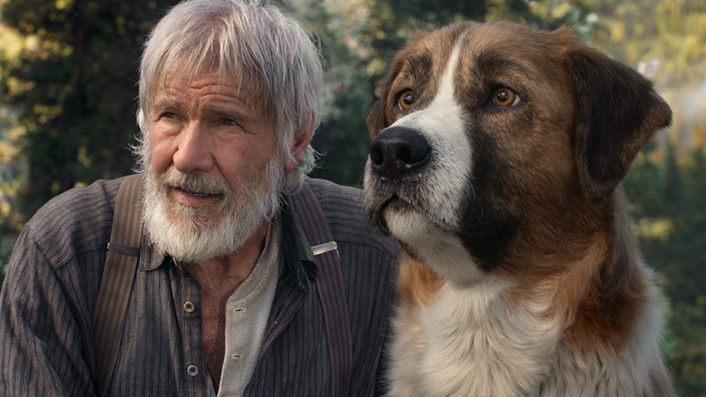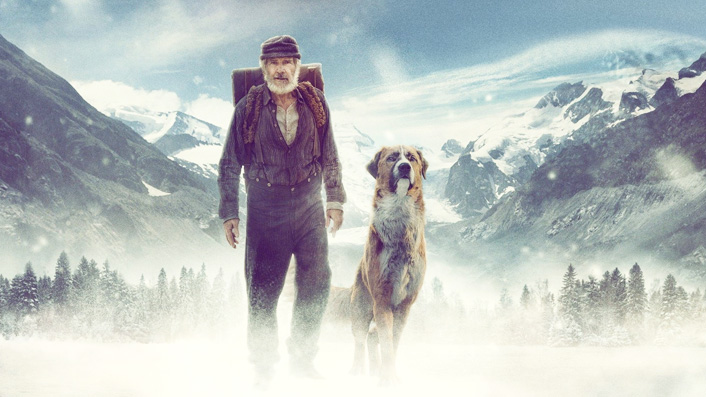The Call of the Wild is a beautiful big-hearted adventure starring a very good boy

A magnificent CGI-animated pooch stars alongside Harrison Ford in this old-timey adventure based in a variety of exotic locations. The Call of the Wild is a rare kind of family film, writes critic Luke Buckmaster, spanning a full spectrum of emotions.
“It was in all the papers at the time…” begins Harrison Ford’s voice-over narration in The Call of the Wild, those legend-contemplating words delivered in that deliciously distinctive growl. It’s as if the veteran actor found a way to melt down a beautiful piece of antique furniture and turn into a breath mint, popped before the microphone switched on and the camera started rolling.
This introduction sets in motion an old-timey adventure film that wears its novelic lineage on its sleeve – Michael Green’s screenplay being the latest of many adaptations of Jack London’s 1903 adventure novel. Set in the 1890s during the Klondike Gold Rush, Ford’s woody narration (the armoire of elocution? The mahogany of modulation?) mentions gold-diggers toiling away for their shot at a fortune, before moving onto a more pressing subject, the star of the show and hero of the story: a huge St. Bernard-Scotch Collie named Buck.
This magnificent pooch is a very good boy, created through motion capture technology: the result of CGI layered over the body of former Cirque du Soleil performer Terry Notary. Unlike Disney’s wretched The Lion King remake, which combined talking animals with photorealist aesthetic but never achieved more than a lifeless simulacrum, the artifice of the filmmaking process doesn’t inhibit The Call of the Wild’s appreciation of the natural world – nor its capacity for wonder.
Buck is more or less bound by the laws of our universe, director Chris Sanders using animation as an opportunity to exaggerate his human-like tendencies. Sanders acknowledges anthropomorphism as an ingrained aspect of human psychology and crafts an experience that replicates real world dog behaviour, as well as imagines how people wish them to be: a curious merging of realism and wishful fantasy that could not have been achieved if an actual animal had been used during filming.
We can clearly read the emotions on Buck’s face, for instance, and there are times when he takes decisive human-like actions. These include confiscating a bottle of booze (by putting it in his mouth then sitting on it) because he disapproves of alcohol being used as a coping mechanism for dealing with grief. Like I said: he’s a very good boy.
Buck has four sets of ‘masters’ over the course of the narrative, though that word feels passé these days – perhaps we should just say he has four families. After being abducted from his ritzy first home in California, Buck ends up in Yukon, Canada, joining a dog sled team run by demanding but fair French-Canadian mail dispatchers Perrault (Omar Sy) and Francoise (Cara Gee).
Ford’s voice-over – that armoire of elocution, that mahogany of modulation – explains that here Buck learns qualities of leadership and camaraderie. In one lovely shot he and the other dogs drag the sled at fast speed around windy corners and across snow-covered landscape as the image, unbroken, captures day turning to night, then night to day, then day to night again. Sanders condenses time, propelling the narrative forward without resorting to the tired techniques of montage.
John Thornton (Ford) is the final ‘master’, the last act detailing he and Buck’s quiet life living in a cabin adjacent to a river in a picturesque location. The tone and tenor of these moments is so pleasant and pleasing I found myself dreading the inevitable return of the villain, a swinish American (Dan Stevens) whose professional and personal failures have manifested into violent resentment towards the grizzled, grieving but thoroughly decent Thornton, who has never recovered from the unexpected death of his son several years ago.

In these moments the bedrock values of the film are articulated. Discussing the presence of timber wolves in one-way dialogue with Buck, Thornton notes that “this is their domain, they own these hills.” The Call of the Wild rejects the egocentric view of humans as the center of the natural universe, around which all life orbits.
When Thornton chances upon gold in them thar rivers, he takes a lot out but ends up turfing much of it back in. As he turfs the precious rocks back into the water, he projects to Buck that the gold he has already collected has given him “groceries for life” and “no-one needs more than that.” It’s one of numerous digs at capitalist greed, arriving at a particularly salient time in the era of the climate crisis, when we are beginning to see in terrible clarity some of the grotesque consequences of a natural world corroded by human societies obsessed with perpetual wealth creation.
None of these points are laboured in The Call of the Wild: a beautiful film in aesthetic, setting, staging and sentiment. Magnificent images of largess counter an ultimately intimate story. The trailer and marketing materials barely even hint at the full emotional spectrum explored. The bright bits are very bright and the somber moments have genuine, saddening pathos. The film’s nuance is reflected in the trajectory of Thornton’s character: a broken man who heals, but does not come close to healing completely.

















